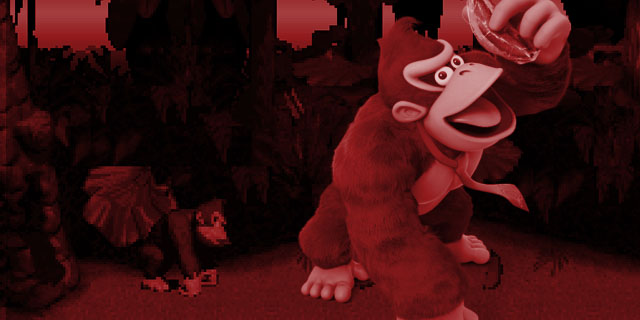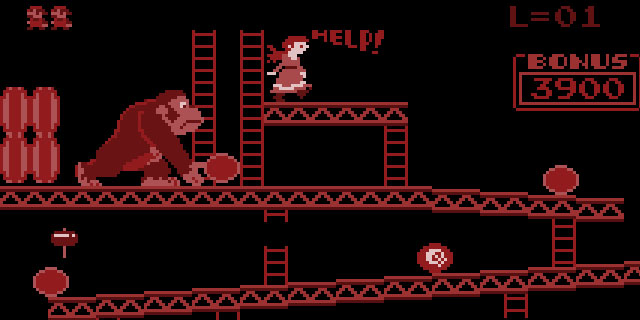In From Pixels to Polygons, we examine classic game franchises that have survived the long transition from the 8- or 16-bit era to the current console generation.
After months of looking at the evolution of gaming’s biggest franchises, it’s time to end this year’s run of From Pixels to Polygons by looking at the game (and series) that helped put Nintendo on the map: Donkey Kong. It may not be as popular as Mario or as well-received as Zelda, but Donkey Kong has a long and storied history and is still going strong today.
The origins of Kong
 Donkey Kong is a simple game; Mario must avoid enemies, as well as barrels thrown by the titular gorilla, while climbing up various construction set pieces in a mad dash to rescue his then-girlfriend, Pauline. What makes Donkey Kong really interesting (aside from its beginnings as a Popeye game, which is just weird) is that it is the first game to have a complete narrative unfold on screen during gameplay. The evil ape kidnaps the girl, then the hero chases after him and eventually saves her. The game even used animations not only for mechanical purposes, but for characterization. The following franchise continues to acknowledge the original arcade game and its sequel, Donkey Kong Jr., in an ongoing canon that has been developing since the early ’80s.
Donkey Kong is a simple game; Mario must avoid enemies, as well as barrels thrown by the titular gorilla, while climbing up various construction set pieces in a mad dash to rescue his then-girlfriend, Pauline. What makes Donkey Kong really interesting (aside from its beginnings as a Popeye game, which is just weird) is that it is the first game to have a complete narrative unfold on screen during gameplay. The evil ape kidnaps the girl, then the hero chases after him and eventually saves her. The game even used animations not only for mechanical purposes, but for characterization. The following franchise continues to acknowledge the original arcade game and its sequel, Donkey Kong Jr., in an ongoing canon that has been developing since the early ’80s.
Speaking of narrative, Donkey Kong Jr. flipped it on its head. Mario was suddenly presented as the bad guy, keeping Donkey Kong locked up in a cage as his son fought to turn the tables. This is Mario’s sole presence as a villain in any game. The major mechanical difference is that Jr. was much more athletic than Mario, and the game had him swinging across vines instead of climbing ladders. He could defeat enemies by dropping fruit on them, and could scale vines faster by grabbing two at once.
Donkey Kong 3 was a bizarre departure from the direction towards narrative-based arcade gaming, and a swing back towards a more traditional experience. Pest control “bugman” Stanley was the hero this time, and the game took on a more familiar shooter style as he fought to defend his flower bed from bees… and Donkey Kong. Like I said, bizarre. Donkey Kong 3 was fairly successful, but didn’t carry the cultural weight of its predecessors, and Stanley quickly faded into obscurity. – Lucas White
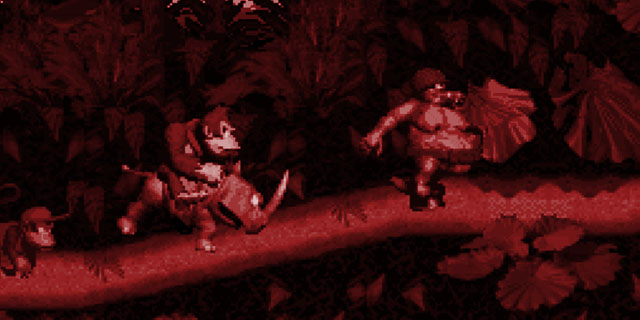
The king of the jungle
 What could Nintendo do in 1994 to renew interest in an aging system? Create one of the most beautiful platformers ever made. Donkey Kong Country was revolutionary in that it was one of the first to use pre-rendered 3D graphics on a console. We’d simply never seen anything like it before: level design was creative, cooperative play was possible, there were tons of secrets to discover, controls were airtight and animal buddies were just as fun to ride as any vehicle. Did I mention it has one of the best soundtracks on the Super Nintendo? David Wise created many timeless classics, from the peaceful Aquatic Ambience to the aggressive synth beat of Fear Factory.
What could Nintendo do in 1994 to renew interest in an aging system? Create one of the most beautiful platformers ever made. Donkey Kong Country was revolutionary in that it was one of the first to use pre-rendered 3D graphics on a console. We’d simply never seen anything like it before: level design was creative, cooperative play was possible, there were tons of secrets to discover, controls were airtight and animal buddies were just as fun to ride as any vehicle. Did I mention it has one of the best soundtracks on the Super Nintendo? David Wise created many timeless classics, from the peaceful Aquatic Ambience to the aggressive synth beat of Fear Factory.
Donkey Kong Country 2, released a year later, brought most of the same team back and made it bigger and better than its predecessor. Sure, we didn’t get the shock value since we knew what Donkey Kong Country looked like, but we got better levels, a great new character in Dixie, way more collectibles, a bonus world, trivia, new animal buddies and a bigger challenge.
The third game is probably regarded as the weakest of the trilogy. Instead of just going level to level, you gain access to new vehicles like the Motor Boat and Hovercraft which can traverse to new areas. DK coins were now all guarded by a Kremling called Koin. Players not only had to find the enemy, but figure out a way to bump him from behind with a steel barrel. There’s more than a few trading sequences, giving players more to do that just platforming levels. It wasn’t on par with the core DKC gameplay, but it still worked. – Henry Skey
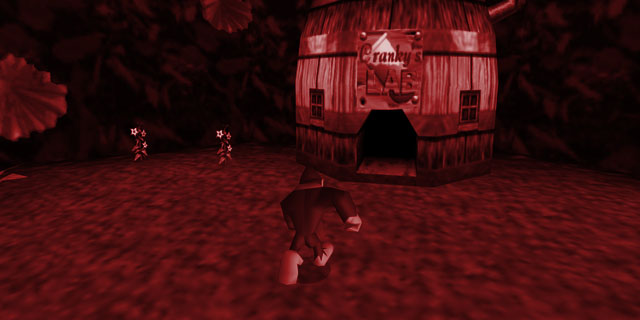
Swinging to new dimensions
 Donkey Kong 64 continued the 3D platformer in the style that started with Super Mario 64 and was refined by Rare in Banjo-Kazooie. Donkey Kong 64 was an enormous game, with more collectibles than most people could stand, a stable of playable characters, multiplayer and even some classic arcade games. The levels were massive, the characters were well-defined and hilarious, and the Kongs… rapped and had guns. The jury is still out on that one. Goofiness aside, the scope of the game was grand, and the production values were top-notch.
Donkey Kong 64 continued the 3D platformer in the style that started with Super Mario 64 and was refined by Rare in Banjo-Kazooie. Donkey Kong 64 was an enormous game, with more collectibles than most people could stand, a stable of playable characters, multiplayer and even some classic arcade games. The levels were massive, the characters were well-defined and hilarious, and the Kongs… rapped and had guns. The jury is still out on that one. Goofiness aside, the scope of the game was grand, and the production values were top-notch.
Donkey Kong’s next platformer, Jungle Beat, was not a part of the Country series and required the DK Bongos to play. The platforming and combo-based combat were all dependent on the player’s rhythm ability, and the game was designed around shorter bursts of play time and score attacking. – Lucas White
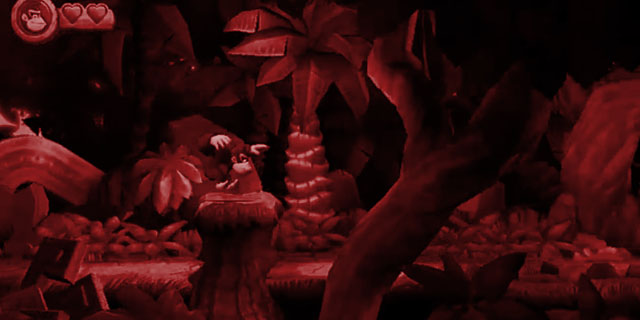
Return of the king
 Donkey Kong Country Returns may have seemed very similar to the SNES titles, but it looked and played slightly differently. Instead of each Kong getting one hit before getting knocked out, they now had two hits each. The curiosity: if Diddy and Donkey weren’t teamed up, your jumping ability was hindered. Thankfully, the music remained fantastic, clearly paying homage to the original. There were no Kremlin enemies this time, but fantastic levels (particularly in the last few worlds) more than made up for it. It’s also the hardest one out of the four, by far. Some levels are cruel, but you’ll always keep coming back for more, especially to get those secrets.
Donkey Kong Country Returns may have seemed very similar to the SNES titles, but it looked and played slightly differently. Instead of each Kong getting one hit before getting knocked out, they now had two hits each. The curiosity: if Diddy and Donkey weren’t teamed up, your jumping ability was hindered. Thankfully, the music remained fantastic, clearly paying homage to the original. There were no Kremlin enemies this time, but fantastic levels (particularly in the last few worlds) more than made up for it. It’s also the hardest one out of the four, by far. Some levels are cruel, but you’ll always keep coming back for more, especially to get those secrets.
Thankfully, we won’t have to wait another 14 years for another Donkey Kong Country: a new title, Tropical Freeze, is slated for early next year. Swimming levels are back, with a few changes: oxygen is now a mechanic and players have an underwater attack. – Henry Skey
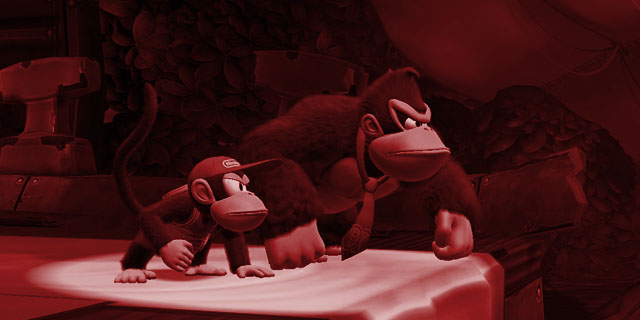
What’s the peak of the Donkey Kong series?
 Lucas: The first Country game holds a lot of sentimental value for me, but I can’t deny that Donkey Kong Country 2 is the better game. The levels hold a ton of variety, the soundtrack is phenomenal and all of the different animals expand the already finely-tuned mechanics.
Lucas: The first Country game holds a lot of sentimental value for me, but I can’t deny that Donkey Kong Country 2 is the better game. The levels hold a ton of variety, the soundtrack is phenomenal and all of the different animals expand the already finely-tuned mechanics.
 Henry: Donkey Kong Country 2 is still my favorite. Dixie’s floating ability combined with Diddy’s speed made them my favorite duo. I’m convinced this game has some of the best levels and animals to date.
Henry: Donkey Kong Country 2 is still my favorite. Dixie’s floating ability combined with Diddy’s speed made them my favorite duo. I’m convinced this game has some of the best levels and animals to date.



